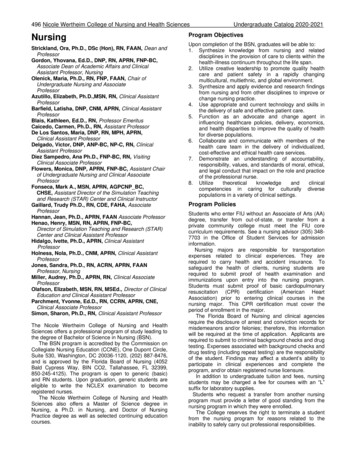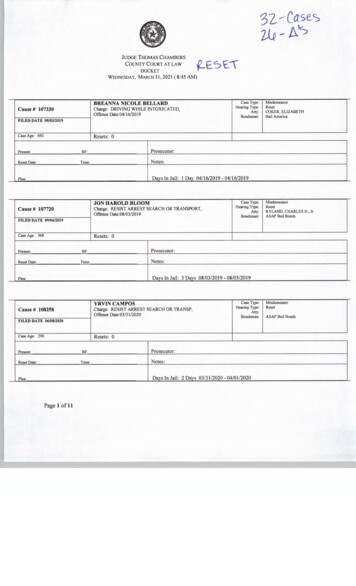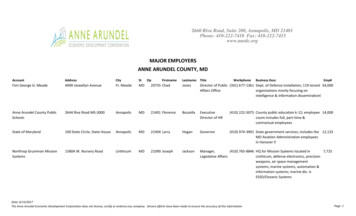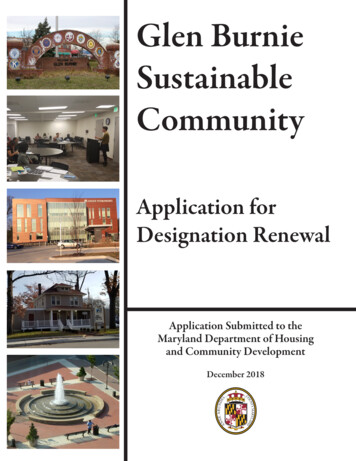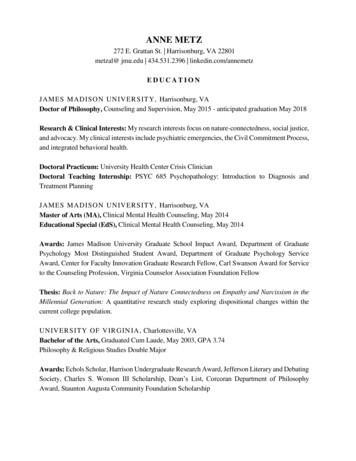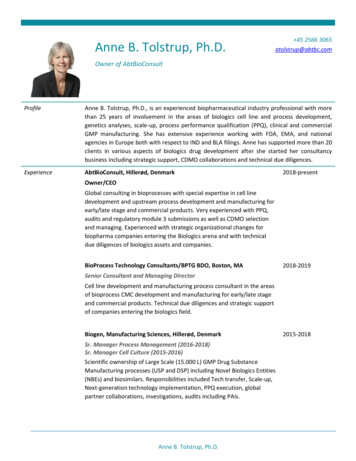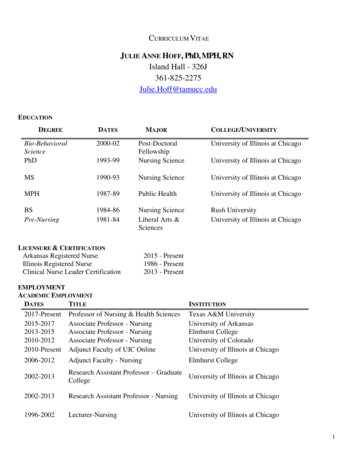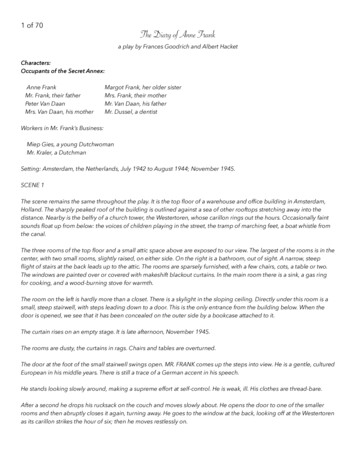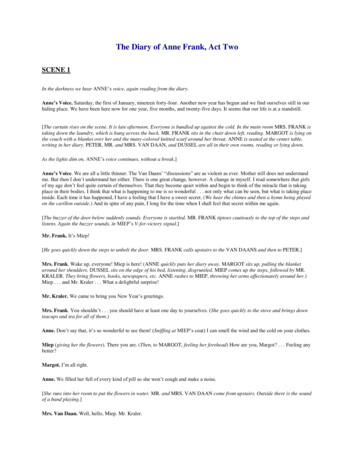
Transcription
CopyrightByNicole Anne Deatherage2020
Urban Landscape Attributes and Intraguild Competition Affect San Joaquin Kit Fox Occupancyand Spatiotemporal ActivityNicole Anne DeatherageDepartment of Biology, California State University, BakersfieldABSTRACTHuman population growth and rapid urbanization have created new, attractiveenvironments for opportunistic animals including some species of wild canids. San Joaquin kitfoxes (Vulpes macrotis mutica) are a federally listed endangered and California listed threatenedcanid that persists in the city of Bakersfield, California, where they form a unique ecologicalguild with three other canid competitors: coyotes (Canis latrans), red foxes (Vulpes vulpes), andgray foxes (Urocyon cinereoargenteus). These four canids typically exhibit avoidance and/orresource partitioning due to overlapping niches, with smaller fox species avoiding attacks frommore dominant foxes and coyotes by selecting alternative resources, finding refuge, occupyingdifferent habitat types, or adjusting behavior. Recent carnivore sympatry in urban areas may bedue to behavioral adjustments and adaptations to complex urban environments, includingheterogeneous landscape matrices and new, abundant resources.I investigated carnivore sympatry in urban environments using 5 y of remote camerasurvey data collected throughout the city of Bakersfield to first determine how landscapeattributes within heterogeneous urban landscapes influence San Joaquin kit fox occupancypatterns, and if canid competitors (i.e., coyotes, red foxes, and gray foxes) affect San Joaquin kitfox distributions with the use of occupancy modeling. Second, I investigated how the presence
of canid competitors or domestic dogs (Canis familiaris) in the same 1-km2 area affects SanJoaquin kit fox spatiotemporal activity with the use of Two-way Contingency Tables, One-wayAnalysis of Variance, and Kruskal-Wallis tests. I found the most supported occupancy model forSan Joaquin kit foxes to be an additive effect of two urban landscape attributes, percentages ofpaved roads and campuses (e.g., schools, churches, and medical centers) in cells. The percentageof paved roads was a negative predictor of San Joaquin kit fox occupancy while the percentageof campuses was a positive predictor. The percentage of paved roads was ultimately the mostsupported covariate for predicting San Joaquin kit fox occupancy (or lack thereof) in my studysystem. Roads are the main source of mortality for urban San Joaquin kit foxes and have greaternoise pollution, development, disturbance, and human activity, which may discourage SanJoaquin kit foxes from incorporating roads into their urban home ranges. Conversely, campuseshave landscaping, sports yards, quadrangles, and walkways that offer open space, which SanJoaquin kit foxes select for in natural habitats. These sites also afford security from excesshuman disturbance and larger predators due to fences and other security measures employed bycampuses, as well as anthropogenic food sources from cafeterias and people directly feeding SanJoaquin kit foxes. I concluded that San Joaquin kit foxes were avoiding paved roads whileselecting for campuses in the urban environment. The presence of coyotes, red foxes, and grayfoxes was not a contributing factor of urban San Joaquin kit fox occupancy patterns, though thismay have been a result of low sample sizes of other canids compared to San Joaquin kit foxes.Apart from one association between the number of days in which San Joaquin kit foxesoccurred alone and the number of days in which they occur with other canids in 2018, I found noother associations between San Joaquin kit fox and other canid occurrences in cells or on givendays. I also found differences between the number of days San Joaquin kit foxes occurred alone
and the number of days they occurred with another canid for all years collectively and each yearindividually. I concluded that urban San Joaquin kit foxes rarely occur with coyotes, red foxes,gray foxes, and domestic dogs in the same 1-km2 area within the same day, same year, or 5-yspan, suggesting spatiotemporal avoidance of canid competitors. In instances when San Joaquinkit foxes and other canids did occur on the same camera on the same survey night, I found SanJoaquin kit foxes delay their time to appearance following sunset by about 3 h at camera stationswhere another canid species appeared. Furthermore, variances in mean consecutive min that SanJoaquin kit foxes spent at stations showed that they had the least predictability in the potentialwindow of time spent at the station if another canid visited the camera station on the same nightbut did not appear first. San Joaquin kit foxes had the most predictability in the potentialwindow of time spent at the station if another canid appeared first. These results indicate thatSan Joaquin kit foxes may require a more immediate predator presence cue than scent toperceive imminent risk from nearby competitors. Finally, my results show that if multiple canidspecies did occur there were never more than three, though primarily only two canids occurred inany given cell or on any given day, with a majority of co-occurrences between kit foxes anddomestic dogs. Because domestic dogs are abundant in urban areas, they may not be novel orthreatening to kit foxes, allowing domestic dogs and kit foxes to co-occur at higher frequenciesthan kit foxes and other wild canids. Additionally, where coexistence does occur, canids mayonly be willing to exist with one other canid species at any given time.In both analyses, I confirm that San Joaquin kit foxes occur in higher abundances thanany other wild canid species in Bakersfield. San Joaquin kit foxes may be more receptive andadaptive to highly developed urban areas than other canids and are frequently observed denningin inner city landscapes; whereas past studies show that coyotes require larger, connected ranges
and natural habitat, that red foxes avoid coyotes in intermediate human-modified habitats (i.e.,suburbs with house densities of 20 houses/ha), and that gray foxes select for urban edges ormore natural, tree covered areas. My results also demonstrated a sizeable decrease in kit foxabundance over the years, with a 69% decrease in San Joaquin kit fox abundance at camerastations and a 40% decrease in probability of San Joaquin kit fox occupancy from 2015 to 2019.This is explained by the recent outbreak of sarcoptic mange (Sarcoptes scabiei) skin disease inSan Joaquin kit foxes in Bakersfield, which is highly infectious and 100% fatal in untreated kitfoxes.Overall, I conclude that while San Joaquin kit foxes rarely occur with other canid specieswithin a 1-km2 urban area, they may require immediate predator presence cues to perceive riskfrom competition, while avoidance of paved roads and selection for campuses as urban landscapecharacteristics may be of greater importance in explaining occupancy dynamics in urban SanJoaquin kit foxes. Understanding how top predators adapt to developing landscapes providesinsight towards species conservation and management in urban areas, which is particularlyimportant for the San Joaquin kit fox. Conserving the unique urban population in Bakersfieldmay be significant for the overall health, survival, and recovery of this species as humandevelopment is projected to continue, and upcoming conservation efforts may be particularlycritical considering the current mange epidemic within this population.
URBAN LANDSCAPE ATTRIBUTES AND INTRAGUILD COMPETITION AFFECT SAN JOAQUIN KIT FOXOCCUPANCY AND SPATIOTEMPORAL ACTIVITYByNicole Anne Deatherage, B.S.A Thesis Submitted to the Department of BiologyCalifornia State University, BakersfieldIn Partial Fulfillment for the Degree of Masters of ScienceSpring 2020
Urban Landscape Attributes and Intraguild Competition Affect San Joaquin Kit FoxOccupancy and Spatiotemporal ActivityBy Nicole Anne DeatherageThis thesis has been accepted on behalf of the Department of Biology by their supervisorycommittee:Dr. David J. GermanoCommittee ChairDr. Brian L. CypherDr. Carl T. Kloocki
ACKNOWLEDGEMENTSMy thesis expands on previous work completed by Dr. Brian L. Cypher with theEndangered Species Recovery Program (ESRP) of California State University, Stanislaus. Assuch, much of the background, research direction, and methods have referenced his and hiscolleague’s published work. My thesis committee chair, Dr. David J. Germano, and committeemember, Dr. Carl T. Kloock, of California State University, Bakersfield (CSUB) have assistedwith data analysis and writing through guidance and review. In addition, Dr. James Murdoch ofUniversity of Vermont provided direction on statistical analysis and occupancy modeling of mydata. Funding and materials have been generously provided by the Endangered SpeciesRecovery Program, The San Joaquin Valley Chapter of The Wildlife Society, The WesternSection of The Wildlife Society, as well as the Graduate Equity Fellowship and Fairie DeckerMemorial Endowment Fund of CSUB.Preliminary camera data for my analyses were collected and reviewed by ESRPpersonnel, including Tory Westall, Erica Kelly, Larry Saslaw, and Christine Van Horn Job. Toryand Erica in particular have familiarized me with protocols, helped to develop my datasets, andhaving both completed a M.S. in Biology at CSUB, have provided invaluable support towardsthe development and completion of my thesis.In addition, I thank Angela Madsen of CSUB for her confidence and editing of drafts ofmy thesis, and Olga Rodriguez of U.S. Geological Survey for aiding with GIS mapping. I thankmy parents, Nancy Armendaris and Michael Deatherage, and friends, Jordyn Carkhuff and AprilPurdy, for providing unconditional encouragement, support, humor, and hard truths. I thank“Aunt Wonderful” for all her support in showing me the natural world and inspiring my love forii
wildlife. Finally, I thank Philip Schoepfle for his patience, support, and tranquility during mythesis work.iii
TABLE OF CONTENTSCHAPTER 1 INTRODUCTION. 1LITERATURE CITED . 11CHAPTER 2 URBAN LANDSCAPE ATTRIBUTES AFFECT SAN JOAQUIN KIT FOX OCCUPANCYPATTERNS . 19CONFLICTS OF INTEREST . 19ACKNOWLEDGEMENTS . 19ABSTRACT. 21INTRODUCTION . 22MATERIALS AND METHODS . 25Study area . 25Study design . 26Occupancy analysis . 28RESULTS . 31Occupancy analysis . 31DISCUSSION . 33REFERENCES . 38FIGURE CAPTIONS . 45TABLES . 51CHAPTER 3 SPATIOTEMPORAL PATTERNS OF SAN JOAQUIN KIT FOXES AND AN URBAN CANIDGUILD . 57ABSTRACT. 58METHODS. 62Study Area . 62Field Methods . 62Spatial Analyses . 64Temporal Analyses . 64RESULTS . 65Spatial Analyses . 66Temporal Analyses . 66DISCUSSION . 68ACKNOWLEDGMENTS . 71LITERATURE CITED . 71TABLES . 79iv
FIGURES . 82CHAPTER 4 SUMMARY OF RESEARCH AND IMPLICATIONS. 86Urban landscape attributes affect San Joaquin kit fox occupancy patterns . 87Spatiotemporal patterns of San Joaquin kit foxes and an urban canid guild . 88Urban carnivore conflicts and concerns . 90Urban San Joaquin kit fox conservation and management . 90LITERATURE CITED . 92v
LIST OF TABLESCHAPTER 2Table 1. Covariate abbreviations and descriptions used in San Joaquin kit fox occupancymodeling of grid cells surveyed annually from 2015 to 2019 in Bakersfield, California . 51Table 2. The total number of surveys, species counts, and surveys with kit foxes and/or othercanids (coyotes, red foxes, and gray foxes) from an annual remote camera survey of grid cellsin Bakersfield, California from 2015 to 2019 . 52Table 3. Number of survey grid cells characterized by a majority percentage of urban landscapeattributes, as well as with 20% paved road or mature trees and the presence of a stable watersource for 111 cells from 2015 to 2019 in Bakersfield, California . 53Table 4. Correlated pair-wise habitat attributes and Spearman correlation test statistic (t),adjusted P value (P), and Spearman correlation coefficient values (rs) for a total of n 111survey grid cells from 2015 to 2019 in Bakersfield, California . 54Table 5. Model ranking, name, number of parameters (no. par), Akaike Information Criterionvalue (AIC), the difference in AIC values between the given model and the top ranking model(ΔAIC), and the AIC weight (w) from San Joaquin kit fox occupancy modeling in Bakersfield,California from 2015 to 2019 . 56Table 6. Model ranking, name, and maximum-likelihood estimate for the given parameters ofthe model (β) with 95% confidence intervals (CI) from San Joaquin kit fox occupancymodeling in Bakersfield, California from 2015 to 2019 . 57CHAPTER 3Table 1. The total number of individuals (n 604 for individual species, n 2,693 for speciescombinations), surveyed grid cells (n 545), and surveyed days (n 3,806) that each canidspecies (SJKF San Joaquin kit fox, Coy coyote, RF red fox, GF gray fox, Dog domestic dog), or species combination, occurred during an annual camera survey of 105 to111 cells (depending on the year) in Bakersfield, California from 2015 to 2019. . 79Table 2. The number of individuals (n 164 for total individual species, n 772 for total speciescombinations), surveyed grid cells (n 105), and surveyed days (n 735) that each canidspecies (SJKF San Joaquin kit fox, Coy coyote, RF red fox, GF gray fox, Dog domestic dog), or species combination, occurred during a camera survey of 105 cells inBakersfield, California in 2015. . 80Table 3. The number (No.) of individuals, surveyed grid cells, and surveyed days that each canidspecies (SJKF San Joaquin kit fox, Coy coyote, RF red fox, GF gray fox, Dog domestic dog), or species combination, occurred during an annual camera survey inBakersfield, California from 2016 to 2019. The number of observations (n) is included foreach year below each heading; for number of individuals, the total number of observations forvi
single species (Sgl) and total number of observations for species in combinations (Com) areincluded. . 81vii
LIST OF FIGURESCHAPTER 1Figure 1. Urban areas ( 50,000 people) and urban clusters ( 2,500 people) of the United Statesin 2010. (Map by the United States Census Bureau). .2Figure 2. A (A) coyote, (B) red fox, (C) gray fox, and (D) San Joaquin kit fox pictured visitingbaited camera stations in or around Bakersfield, California in 2017 and 2018. (Photographsby the Endangered Species Recovery Program, California State University, Stanislaus). .4Figure 3. A coyote (right) chases a San Joaquin kit fox (left) into a den at Carrizo Plain NationalMonument, California. The kit fox enters the den at 0244 on 5 May 2018, followed by thecoyote at 0245 on the same date. (Photographs by the Endangered Species RecoveryProgram, California State University, Stanislaus). .6Figure 4. A coyote (left) and San Joaquin kit fox (right) in urban areas of Bakersfield, Californiain 2014 and 2015. (Photographs by the Endangered Species Recovery Program, CaliforniaState University, Stanislaus).9CHAPTER 2Figure 1. Land use and cover of the San Joaquin Valley of central California in 2004. The cityof Bakersfield is
Recovery Program, The San Joaquin Valley Chapter of The Wildlife Society, The Western Section of The Wildlife Society, as well as the Graduate Equity Fellowship and Fairie Decker Memorial Endowment Fund of CSUB. Preliminary camera


